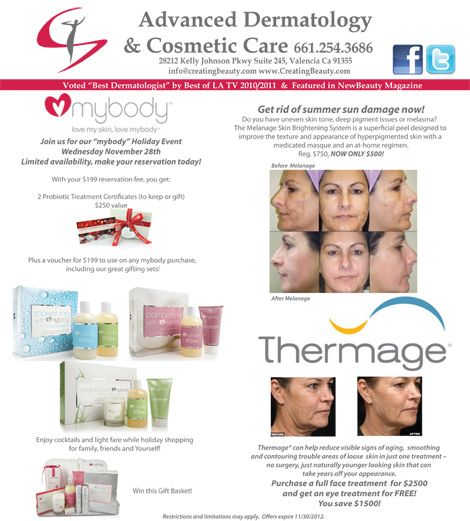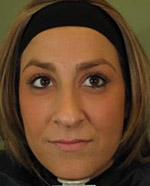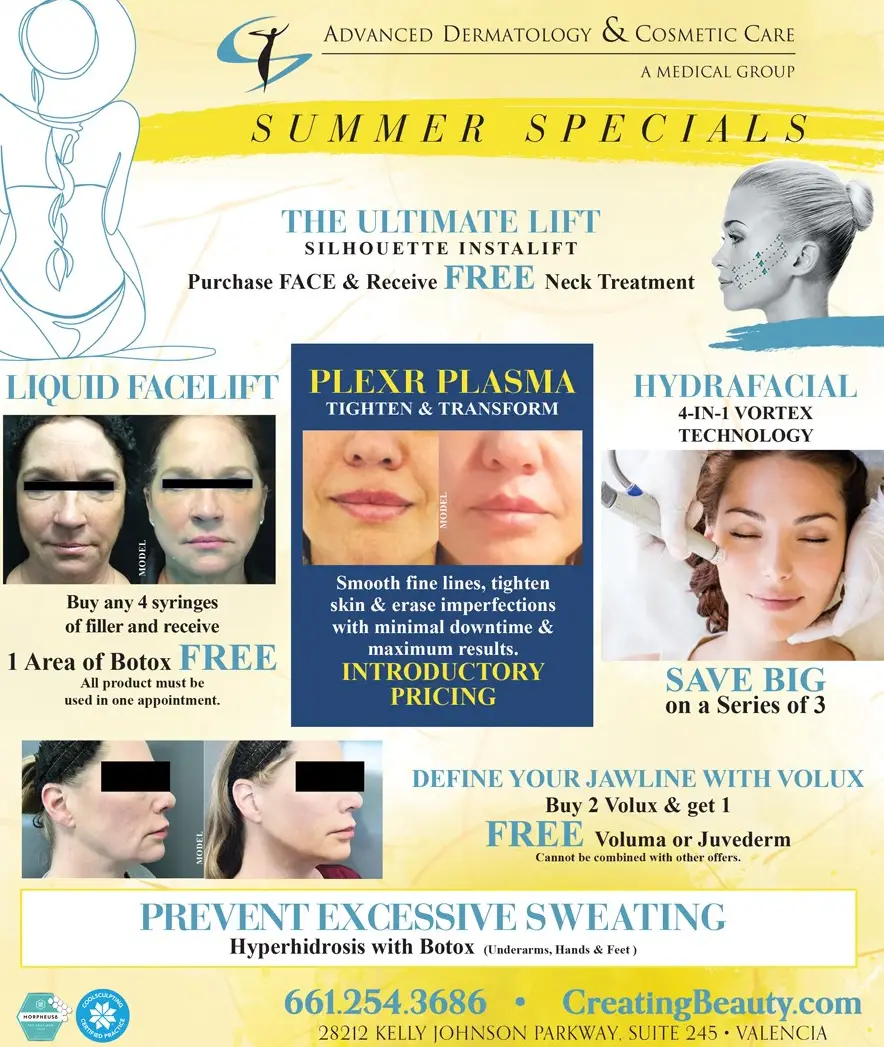Blog
mybody™ Holiday Event
Posted on November 6th, 2012Join us for our mybody™ Holiday Event
Wednesday November 28th
Limited availability, make your reservation today!
With your $199 reservation fee, you get:
- 2 Probiotic Treatment Certi cates (to keep or gift) $250 value
- Plus a voucher for $199 to use on any mybody purchase,
including our great gifting sets!
mybody™ Launch Event
Posted on October 16th, 2012When:
Thursday November 1st 5-8pm
What:
15% off all mybody products
FREE Probiotic treatment with $250 purchase
2 FREE Probiotic treatments with $500 purchase
$550 gift basket raffle
Appetizers and drinks will be served
Day of Creating Beauty Holiday Event
Posted on October 9th, 2012When: Friday, November 9th
Enjoy prizes and giveaways, complimentary neck and shoulder massage, refreshments and more!
Beauty Beach Bash
Posted on July 31st, 2012- SkinMedica gift w/ purchase
- Huge product discounts
- Prizes and giveaways
- Education and Makeovers
Advanced Dermatology & Cosmetic care begins offering CoolSculpting
Posted on July 30th, 2012CoolSculpting by ZELTIQ™ is a breakthrough, non-invasive technology that chills away stubborn fat. CoolSculpting gently targets and cools unwanted fat cells in the selected area to induce a noticeable, natural-looking reduction in fat bulges.
Botox in Santa Clarita
Posted on April 26th, 2012Botox is a procedure performed by Santa Clarita Dermatologist, Dr. Raskin, to help reduce the appearance of fine lines and wrinkles. It works by temporarily paralyzing the muscles of the face to appear smooth on animation. If you are interested in Botox in Santa Clarita, please contact Dr. Raskin to setup a consultation today
Thermage Skin Tightening
Posted on March 16th, 2012There is an inherent beauty to aging that brings with it grace, wisdom and experience and who among us doesn’t want those things? There are also the wrinkles, lines and sagging skin that come with the process due to the loss of collagen. Nobody is happy about that. But what can we do?
Plastic surgery isn’t always the go-to answer for everyone, and not just because of the discomfort, cost and recovery time. Plus, we’re often not in need of such an invasive procedure, just yet. Still, we find ourselves looking in the mirror on occasion, thinking, “Isn’t there something to tighten and shape this skin, soften the wrinkles and lines and maybe, just maybe, renew my confidence?” There is, and its name, is Thermage.
Thermage is a unique procedure that employs radiofrequency (RF) technology to tighten and contour the skin. Right now, Thermage is #1 in patient demand, in part, because it is a non-invasive treatment that can be done in approximately one hour with no recovery time. Your friends and co-workers (even your family) will wonder how you found the time to “go on vacation” and ask how it is that you look so rested and rejuvenated.
The first signs of aging are usually seen in the face, neck and hands due to a loss of collagen. Thermage works to stimulate your body’s own natural stores of collagen, the very thing responsible for keeping skin youthful looking. Your skin is made up of three distinct layers; the epidermis (or outer layer); dermis (beneath the surface); and the subcutaneous tissue (the “fat layer” with its web of collagen fibers) and Thermage works to heat these layers, tightening existing collagen and helping the body to form new collagen. Unlike other methods available, Thermage renews collagen in the dermis and the subcutaneous layer. No surgery, no injections and no downtime.
Thermage has been approved by the FDA and is considered by Dermatologists to be the safest and most effective non-invasive method of tightening and contouring the skin. Thermage can be used to treat the entire face or specific parts of the body and works on all skin colors and types. Currently, more than 500,000 Thermage treatments are performed in 80 countries. Because of its reputation, you can feel confident, knowing that compared to other treatments, Thermage has the longest history of safety and effectiveness.
While other laser procedures require four or more sessions and repeat visits, patients who opt for the Thermage treatment have just one office visit. Some patients get an immediate response, but everyone gets improvement as the body responds to its own natural collagen rebuilding process during the following two to six months. Doctors and patients have also reported that the results can last years.
That magic wand we’ve all been looking for to take care of crow’s feet, tired looking eyes, that excess flap of skin that shows up on the upper eyelid and that crepe-y tissue paper appearance of the skin in that area? Thermage has the first only FDA clearance for non-invasive eyelid treatments, smoothing the skin on the eyelids, reducing under eye.
sagging and giving you brighter looking eyes that appear lifted and less tired. Your hands can receive the same treatment, resulting in the thicker, smoother skin of your younger years. In addition to the long-lasting results of smoother skin on your face, hands and neck, Thermage can also treat other parts of the body, such as the tummy, arms, thighs and buttocks.
Thanks to Thermage, you can have it all: wisdom, grace, experience AND younger, smoother looking skin. And everybody… is happy about that.
The skin you live in. [And the aesthetician that loves it.]
Posted on March 2nd, 2012When you meet someone, even if you extend your hand in greeting, their first true contact with you… is your face. No getting around it. It is the upfront billboard that announces who you are, how you feel and often what you think (yes, that blush will give you away every time). As such, it deserves a little more care and attention. After all, you do want to put your best face forward, no? Well, I’m here to tell you — a facial can be the way to do that.
Whether seeking a facial for dehydration, fine lines acne or hyperpigmentation one of the first things you want to do is find an aesthetician who will take the time to sit with you, do a detailed skin analysis and then customize the appropriate facial for your needs, which is why I was so happy to shake hands and make the acquaintance of the new aesthetician, Claudia Kinzer, of Advance Dermatology & Cosmetic Care in Valencia.
It was more than Claudia’s lifetime of work experience (which included her years as an aesthetician, spa and salon history) that convinced me she was the right person for my skin issues. It was hearing her personal story of being a teenager growing up with acne and her search for improved skin. Acne is the most common skin disorder in the United States, affecting 40 to 50 million Americans and while most associate acne with teens, it is not restricted to any age group and can affect people into their 50’s (as an adult, I’ve often said that at some point wrinkles and acne are going to fight for space on my face). Because of her deeply personal relationship with her own skin, Claudia has dedicated her life to helping clients achieve the best results for theirs. She works to customize facials, taking into account more than just skin type, but lifestyle and the level of commitment to follow-up care once a client leaves the peaceful sanctuary of her treatment room (which, by the way, has a lovely view of the mountains surrounding Santa Clarita and our brilliant blue skies).
One of my first questions about facials had to do with how much time the process would take. I’m a busy person and, like my fellow Santa Claritans, can always find time to volunteer for things around town, but don’t always have the luxury of personal time. Turns out, I could either schedule either a luxuriant 45 minutes, a decadent hour or book an entirely do-able half-hour express facial. What?! 30 minutes? I can definitely treat myself to a lunchtime facial to improve the health and overall appearance of my skin. That, is going to be time well-spent. And, when time allows I am so coming back for the relaxing, stress-relieving facial. In fact, I’m going to purchase a gift certificate for my kid’s hardworking teacher. Or that tireless coach. Or… Wait. We were talking about taking time for ourselves, weren’t we?
Then, I summoned up the courage to ask Claudia some hard-core questions about the facial peels I keep reading about in magazines and ads. The idea of a peel to refresh and renew my skin tone appeals to me, but if I opted for a peel, I wanted to know the honest truth about how much discomfort or down-time I was getting into with the flaking and peeling of it all. Claudia looked me in the eye and let me know that even peels could be customized to suit my needs and lifestyle, with simple peels that involve a minimum of 2 to 3 days, or more intense treatments that take longer.
My last line of questioning had to do with the costs of facials (because I really did want to purchase this gift of a facial for myself and someone else). I discovered that specialized packages of facials, peels and microdermabrasion were the best way to go, not just financially but also in terms of better skin results overall.
Well, yay me! Claudia Kinzer and Advance Dermatology & Cosmetic Care have made it so that I now get to put my best (soon to be softer, brighter and healthier) face forward as this year progresses and I am very happy about that.
Sincerely,
Theresa Katz
Visit Dr. Raskin’s Profile Website
Posted on January 21st, 2012To learn more about Santa Clarita Dermatologist, Dr. Bernard Raskin, please visit his profile website at www.drbernardraskin.com.
Why Everyone Should Include a Product Regimen into Their Skin Care Routine
Posted on January 13th, 2012Acne is the number-one skin disease in the world and is an equal opportunity offender. It does not discriminate against race, age or gender and unfortunately, acne is chronic too — meaning it is reoccurring and persistent.
However, as acne never gives up, neither can its possessor and in order to fight those pesky pimples, a daily skin care regimen must be followed. The repetition of a product regimen is a vital component to beautiful skin and once the right combination is discovered, acne can be controlled and skin will become clear.
We’ll give you some suggestions for finding the correct products for your skin care regimen in the next blog titled Dr. Raskin’s Must Have Products, but first let’s focus on why a skin care regimen is so key to clearing the skin.
Just like you brush your teeth twice a day, you must acquire a clear-skin habit just the same. And while you first must find the right combination of medicines and skin-care products, you must then be diligent with your skin care regimen. Repetition is an important component, nearly as essential as finding that perfect combination. Why? Because your skin does not become clear because your acne is cured, it’s clear because your skin care products are working and your skin care regimen is disciplined. Remember, acne is chronic and the only way to control is, is to continually treat it.
Additionally, a daily skin care regimen is essential because of our skin being constantly exposed to sun, pollutants and free radicals, or clogged by make-up and dirt. These exposures also lead to visible signs of aging, like wrinkles and discoloration. But if you regularly treat those signs of aging with proper skin care products as part of your regimen, they will become less visible and your skin more youthful.
So, now that we all understand why it is so vital to adhere to a daily skin care regimen, next up is figure out what that perfect skin care regimen is. Dr. Raskin and his team of skin care professionals will do just that, so call 661-254-3686 today to schedule an appointment.


















